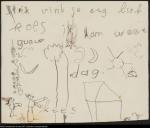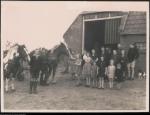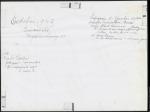
Written, cherished, scanned: the many lives of a wartime letter
Digitisation is giving the historical documents in collection 247: correspondence a new life. Many of them have already lived numerous ‘lives’, however, taking on new meanings each time: the war letters were written, read, saved and cherished before becoming part of an archival collection. In this blogpost, I reflect on how letters keep on acquiring new meanings as these developments unfold.
Letter-writers
The first ‘life’ of a war letter is the one that immediately springs to mind: letter-writers used sheets of paper, postcards and scraps to share their experiences. Historical correspondence is the outcome of how people perceived, interpreted and shaped their surroundings and circumstances in text.

When you read war letters, you get closer to the experiences of their creators, as you examine how the writers entrusted their lived reality and social interactions to paper. This makes these letters a valuable source for historical research, something that Gerrit Bolkestein emphasised as early as 1944: ‘If future generations are to be fully aware of what we as a people have endured in these years (...), it is the simple documents we need: a diary, letters from a worker in Germany, (...).’
Yet, as a researcher, I have found that we can never be entirely sure of the meaning that a historical letter had for its writer and recipient. Sometimes the writer and the recipient were just vague acquaintances, other times they were close family, good friends or lovers. A letter may refer to shared memories, events or acquaintances, and the researcher who’s reading it cannot be party to these. In other cases, information was deliberately omitted, perhaps due to censorship or because it might jeopardise resistance work. The letter shown here (figure 2), for example, raises many questions for today’s reader. Much seems to have been left unsaid, and the resistance fighters may have used coded language in this correspondence.

Owing to the exceptional events of the Second World War and the Indonesian War of Independence, the letters from collection 247 correspondence often retained their special value for the writers, recipients or their relatives for many years to come. As a result, these letters eventually took on a new meaning as cherished heirlooms or as part of a family collection.
Custodians of letters
It was often the letter-writers themselves, the recipients or their relatives who collected and kept war letters. As part of a private collection, the letters took on a new meaning, form and structure. In addition to disposal or destruction, we often come across traces of this phase of meaning-giving in our collection. Whereas some letters and envelopes were kept separately, other correspondence was carefully sorted in chronological order and sometimes even numbered. Some custodians went a step further, adding notes, transcripts or other information to the documents. Yet others collected war letters alongside war diaries or photo albums, and kept them all (sometimes literally, sometimes proverbially) in an old suitcase in the attic.


At a certain point, the documents in Collection 247 entered a new phase. This was sometimes due to illness or the death of a parent or grandparent, or perhaps because of renovations or relocation. Not infrequently, this phase was sparked by the deteriorating condition of the old pieces of paper, or a growing awareness of their value as heritage or source material for historical research. The letters went from being family property to becoming part of a collection, for example in the NIOD archive.
Joining the NIOD collection
Most of the war letters in Collection 247 came to NIOD as donations. Once at NIOD, they were given a unique inventory number and then assigned to one or more sub-collections. Archival descriptions and key words were subsequently added to each inventory number, to make the items easier to find. In the process, NIOD’s work was reflected in the collection, and the letters took on yet another meaning. In the past, all of the separate exchanges of letters did not constitute a single unit. The collection is a series of items of different forms, natures and origins, which have been brought together by archivists under a common denominator. That is why we don’t refer to an ‘archive’ as such – something that is formed by one historical person or organisation – but to a ‘collection’. It is partly for this reason that the collection contains a wide variety of different kinds of letters and letter-writers. And this method is also reflected in the multifaceted nature of the digital dataset of scans and transcriptions we are producing in 'First-Hand Accounts of War’.
Digitisation
As the examples above show, the letters we are working with in ‘First-Hand Accounts of War’ have taken a winding path to their present destination. The collection has its own history, one that has shaped the collection as it exists today. For this reason, it’s important, in my view, for the digitisation project to take account of how the meanings of the wartime letters have changed over time. After all, these developments influence how we study and understand the collection, and how the digital scans and transcripts will be consulted in the future.
So that these developments remain visible, for example, we ensure that anyone who wishes to work on the digital transcripts always has the opportunity to see the (scans of the) original documents. Only in this way can a distinction be made between the transcripts of historical war correspondence, for example, and those of later additions (see also figures 3, 4 and 5).

The digitisation of wartime letters from NIOD is a radical transformation in which old sources are taking on new forms and meanings – but it’s not the first time that these historical sources have embarked on new lives. I therefore see the current digitisation project as yet another phase in a series of processes of meaning-giving; one that began with the letter-writers and recipients themselves, and has now led, through the custodians and archivists, to new, digital variants of Collection 247.
Do you have personal correspondence about the German occupation of the Netherlands during the Second World War, or about the Indonesian War of Independence, lying in an old suitcase in the attic? And is this material ready for a new life? During the ‘Postbus NIOD’ campaign week (31/3/23 – 07/04/23), we’re appealing to the public to donate material like this to NIOD. You will receive a digital copy in return. For registration and the conditions, please see Postbus NIOD .
